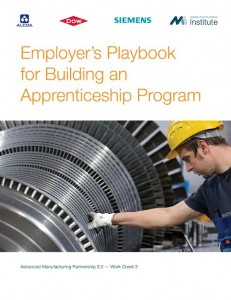 U.S. Manufacturers are facing a serious shortage of skilled workers. Many applicants just don’t seem to have the skills necessary to produce the increasingly sophisticated products that American factories are creating.
U.S. Manufacturers are facing a serious shortage of skilled workers. Many applicants just don’t seem to have the skills necessary to produce the increasingly sophisticated products that American factories are creating.
While some companies are teaming up with community colleges and other partners to create training and apprenticeship programs, there seems to be far too few of them
Three major corporations – Dow, Alcoa and Siemens – have decided to help solve the problem by joining forces to create a coalition to build regional apprenticeship models that bring together employers and community colleges.
And together with The Manufacturing Institute, a Washington, D.C.-based nonprofit, they’ve also published the Employer’s Playbook for Building an Apprenticeship Program to teach other companies how to do it themselves.
This 115-page book serves as a how-to guide that companies of any size can use to help build a workforce-ready talent pipeline in communities across the country.
Readers are taken step by step through the process of establishing an apprenticeship program. The nine chapters cover everything from workforce planning and establishing public-private partnerships to selecting apprenticeship program participants and transitioning apprentices into permanent employment.
The book includes an extensive array of templates, tools, project plans and worksheets and tons of tips and advice that are useful to any company that might be interested in creating an apprenticeship program of their own. There are also links to a wide range of other resources that include everything from the Department of Labor and the National Governor’s Association to the National Association of Workforce Boards.
The playbook will also serve as an important resource for manufacturers and their partners who are interested in the U.S. Department of Labor’s American Apprenticeship Grants competition that is now open for applications.
These grants – up to $100 million in total – will be given to public-private partnerships that will include a combination of manufacturers as well as community colleges, nonprofits, unions and training organizations. The grants are being financed by the fees that employers pay to hire foreign workers to come work in the U.S. under the H-1B nonimmigrant visa program.
The goals of the grant competition are to:
- Expand apprenticeship programs into high growth industries and occupations, especially those for which foreign workers on H-1B visas are hired.
- Use apprenticeships to create new career pathways.
- Offer more apprenticeship opportunities to job seekers and workers, especially those from groups that are underrepresented in traditional apprenticeship programs.
And with all the new training programs that will result from these grants, more Americans – including hopefully some who were formerly incarcerated – will be claiming some of those jobs currently being held by H-1B workers. At least that appears to be the goal.

